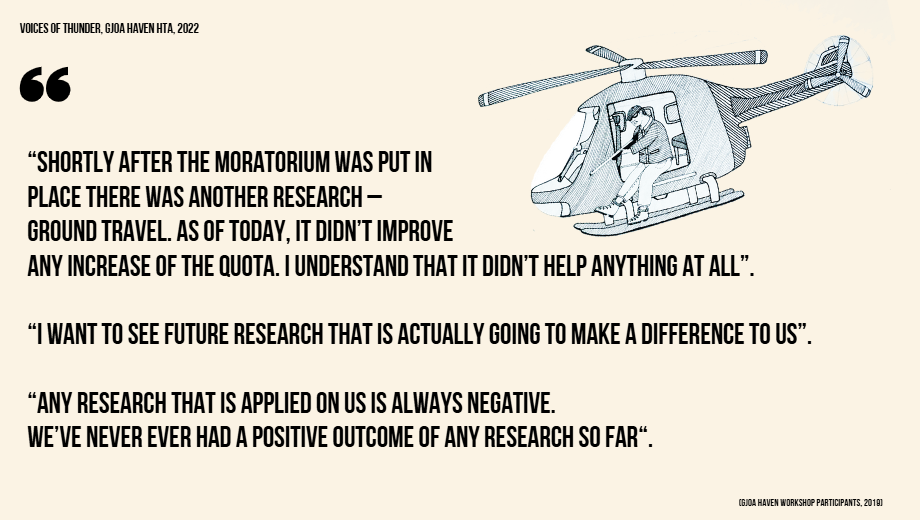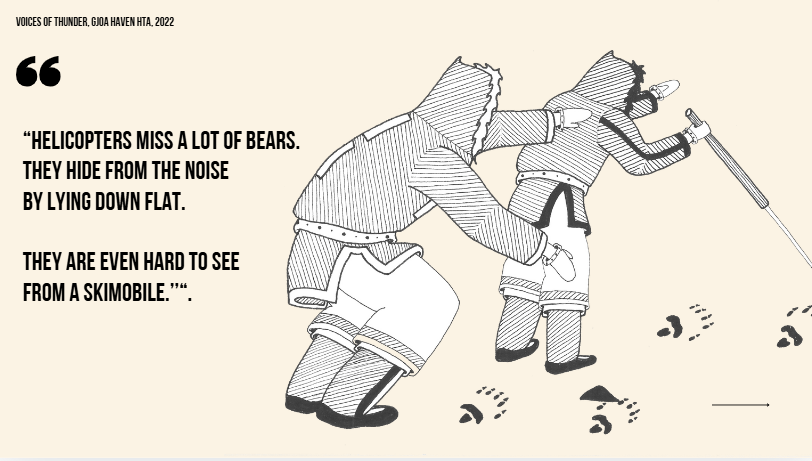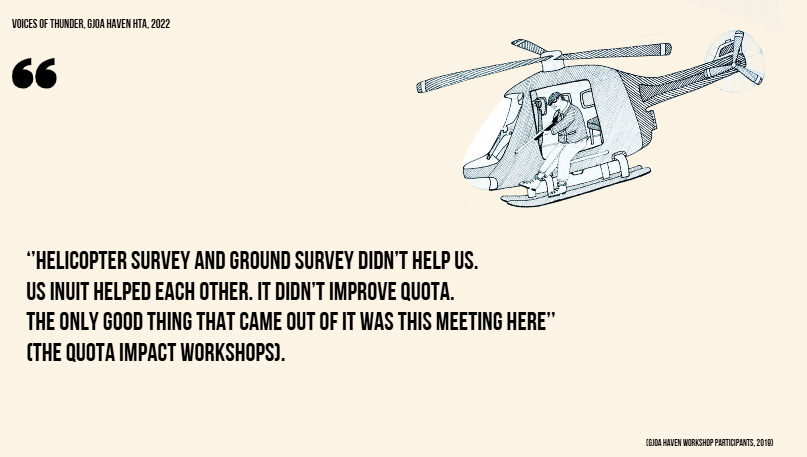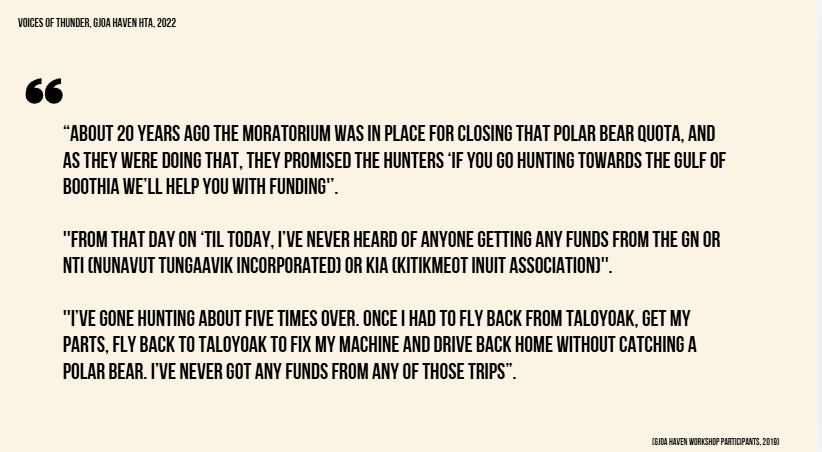Multiple Voices: Difference between revisions
| Line 35: | Line 35: | ||
=Voices of Thunder Animated Graphic Documentary= | =Voices of Thunder Animated Graphic Documentary= | ||
Voices of Thunder Inuktitut Syllabics version | Voices of Thunder Inuktitut Syllabics version | ||
| Line 51: | Line 48: | ||
</html> | </html> | ||
The experiences that are shared in this documentary come from 28 different voices that are narrated as ‘we' in this documentary. The narration of these voices happens through the recorded voice of one speaker from the community, while the archival documentation that provides particularized institutional context is narrated by another speaker from the community. To provide transparency on the multitude that is embedded within this ‘we’, all the community members that contributed to this narrative are named at the end of the video. | |||
<span class="next_choice">There seem to be many tracks entangled with this Motion Graphic Documentary. | |||
Moving forward, and following the Voices of Thunder, leads you to some of the other research outputs. However, you can also take multiple detours. | |||
One brings you to the film’s synopsis and its poster as it was distributed within the film festival circuit. | |||
Another detour set’s you on the track of cut 2: Aesthetic Action, which allows you move alongside the process of film-making within the community. | |||
The last option allows you, depend from where you arrived at this point, to learn more about why this film was made. It will bring you to the beginning of cut 1: Voices of Thunder.</span> | |||
<span class="detour to-cut-1 link" data-page-title="Synopsis_Voices_of_Thunder" data-section-id="0" data-encounter-type="detour">[[Synopsis Voices_of_Thunder|Detour to Cut 1: Voices of Thunder "Synopsis"]]</span> | <span class="detour to-cut-1 link" data-page-title="Synopsis_Voices_of_Thunder" data-section-id="0" data-encounter-type="detour">[[Synopsis Voices_of_Thunder|Detour to Cut 1: Voices of Thunder "Synopsis"]]</span> | ||
<span class="detour to-cut- | <span class="detour to-cut-2 link" data-page-title="Aesthetic_Action" data-section-id="9" data-encounter-type="detour">[[Point of Beginning Animated Graphic Documentary|Cut 2: Aesthetic Action]]</span> | ||
<span class="detour to-cut- | <span class="detour to-cut-1 link" data-page-title="Voices_of_thunder" data-section-id="0" data-encounter-type="detour">[[Voices of Thunder|Detour to Cut 1: Voices of Thunder "Places of Beginning"]]</span> | ||
<span class="return to-cut-3 link" data-page-title="Wayfaring_the_BW_project_Point_of_Beginning" data-section-id="7" data-encounter-type="return">[[Wayfaring the BW project Point of Beginning#Workshops Summer 2019|Return to Cut 3: Wayfaring the BW project: "Workshops 2019"]]</span> | <span class="return to-cut-3 link" data-page-title="Wayfaring_the_BW_project_Point_of_Beginning" data-section-id="7" data-encounter-type="return">[[Wayfaring the BW project Point of Beginning#Workshops Summer 2019|Return to Cut 3: Wayfaring the BW project: "Workshops 2019"]]</span> | ||
Revision as of 22:22, 13 January 2025
Despite the disruptions of Covid-19, we were able to set a course to center Gjoa Haven's Voices of Thunder through academic scholarship, multiple co-created audio/visual outputs, and one-pager communications.
We also navigated the position of the academic scientists when ‘telling’ these stories of quota reduction impacts. Our conversations included discussions on the challenge of presenting Gjoa Haven’s voices and objectives, without the academic partners speaking for the community. We explored how exactly each of our voices could be appropriately leveraged within different knowledge products, including our academic publication.
For example, in the motion graphic documentary, the experiences shared by the workshop participants speak through the voices of Gjoa Haven community members themselves. In the academic paper, on the other hand, the BW scientists are more prominently present as they rethink their own assumptions, recognize the power-relationships between the “reader” and testimonial “text”, and challenge the comfortable concept of being a ‘distant’ other through a "testimonial reading" (Boler, 1997).
You pass a Landmark insight: “multiple sites of enunciation”. Take a closer look at this landmark, to see how it matters that different voices at play have positioned themselves differently in each form of output?
Alternatively, you can keep going and learn more about “testimonial reading”
Landmark: Multiple Sites of Enunciation
Testimonial Reading
Terms like ‘testimony’ or ‘witnessing’ are ideologically and politically loaded. They furthermore may mean different things within different contexts. To ‘witness’, when considered in the context of this cross-cultural research collaboration, doesn’t take up the western legal definition of being an (eye)witness as it would in the context of a legal court. It rather takes up meaning that aligns more with the ways in which it was applied in the public fora of Canadian Truth and Reconciliation Committee hearings. This form of witnessing is active. It is not merely listening, nor is a one-time event.
In the case of our research we follow Megan Boler’s (1997) suggestions for readers or listeners to accept testimony by considering themselves as implicated with the events one accepts testimony for. ‘’…one must recognize oneself as implicated in the social forces that create the climate of obstacles the other must confront’’ (ibid, p. 257).
This approach aligns with some of the guiding principles for reconciliation as put forward by the TRC (TRC, 2015 p. 113). These principles propose an ‘awareness of the past, acknowledgement of the harm that has been inflicted, atonement for the causes, and action to change behaviour’ (ibid). In other words ‘The TRC (...) puts responsibility for change squarely on the shoulders of all Canadians’ (McGregor, 2018 p.823 emphasis mine)- not just the Indigenous people who take up responsibility for sharing their experiences publicly.
Voices of Thunder Testimonies
This cut will continue to trace the knowledge outputs that have emerged from the ongoing conversations between the Gjoa Haven HTA representatives and BW scientists. The outputs consist of, i) Voices of Thunder; an animated motion graphic documentary, ii) Winds of Change; webpage, and iii) Voices of Thunder; an interactive slideshow.
Audiences are invited to engage with these outputs to the degree that feels fitting with their own positionalities. Scientists that practice community-based wildlife monitoring in the Canadian Arctic will likely find some familiarities across their own research contexts and the reflection that the Bearwatch researchers speak to in their testimonial reading. Others, on the other hand, may not have much to gain by conducting a testimonial reading alongside non-Inuit researchers, and would perhaps prefer to only engage with Gjoa Haven’s testimonies directly, by watching the animated graphic documentary and timeline, or exploring the "Winds of Change" website.
Before you continue on your way, you look around in all directions to see whether you are still going into your desired direction. Looking back, you see two tracks. Down the track of cut 1, you can just about (still) see a landmark: Multiple sites of enunciation. Although you can’t really engage with it from here, it reminds you as you keep going that everyone has different places of beginnings, and therefore might travel this path in multiple directions.
You also see a track that may lead you back to Cut 3. If you were redirected from this cut much earlier in your journey, this is your opportunity pick up your wayfaring of the BearWatch project.
Where will you go?
Cut 3: Wayfaring the BW project
Voices of Thunder Animated Graphic Documentary
Voices of Thunder Inuktitut Syllabics version
Voices of Thunder English version
The experiences that are shared in this documentary come from 28 different voices that are narrated as ‘we' in this documentary. The narration of these voices happens through the recorded voice of one speaker from the community, while the archival documentation that provides particularized institutional context is narrated by another speaker from the community. To provide transparency on the multitude that is embedded within this ‘we’, all the community members that contributed to this narrative are named at the end of the video.
There seem to be many tracks entangled with this Motion Graphic Documentary.
Moving forward, and following the Voices of Thunder, leads you to some of the other research outputs. However, you can also take multiple detours.
One brings you to the film’s synopsis and its poster as it was distributed within the film festival circuit.
Another detour set’s you on the track of cut 2: Aesthetic Action, which allows you move alongside the process of film-making within the community.
The last option allows you, depend from where you arrived at this point, to learn more about why this film was made. It will bring you to the beginning of cut 1: Voices of Thunder.
Detour to Cut 1: Voices of Thunder "Synopsis"
Detour to Cut 1: Voices of Thunder "Places of Beginning"
Return to Cut 3: Wayfaring the BW project: "Workshops 2019"
Winds of Change Webpage
As representatives for the larger community, the board had expressed a desire to have the “Voices of Thunder” from the workshops “echo everywhere”. In addition to the motion graphic animation, we responded to this desire by building a “Winds of Change” webpage. The webpage functions as an online advocacy tool and repository for Gjoa Haven’s “Voices of Thunder”, as it gathers much of the other collected material related to Gjoa Haven’s experiences around polar bears. Although this webpage was built by BW researchers, its texts and contents are dictated by the Gjoa Haven HTA board. The voice that speaks of ‘we’ on this webpage, differs from the multitude of individuals and experiences that are narrated in the animated graphic documentary. The voice on this webpage represents a political appeal for recognition as put forward by the HTA board in 2022 as a representative institute. Published in English and Inuktitut, including a Syllabics version, it brings together different material resources that have emerged around the creative collaboration between BW scientists and the Gjoa Haven HTA. Some of these outputs, in particular an interactive timeline (see below), available both in Inuktitut- including a syllabic version- and English, function as a reference source for the “Voices of Thunder” animated graphic documentary, and the HTA’s appeal for recognition. Other content on the webpage facilitates insights on the cultural and place-based embeddedness of Gjoa Haven’s appeals, and the way in which people keep polar bear related practices alive. Either through sharing memories, stories and extended insights on human/polar bear relationships, or by remembering family histories and great hunters of the past through drumdancing and Pihhiq’s (ancestral songs). The page also contains video recordings in which several community members share such memories and stories.
Voices of Thunder Interactive Slideshow
During the co-production of the animated graphic documentary, it became clear that in addition to an academic publication, webpage and video production, a third way of presenting the experiences as shared by Gjoa Haven’s community members, might be desirable. A document that would provide all the same information, arts and experiences that were shared in the animated graphic documentary- but could also afford for a more responsive way of interacting with Gjoa Haven’s testimonies. A supplemental form of output to the video and webpage, was created in the form of interactive slides, available in three versions; English, Inuktitut, and Inuktitut syllabics. It was added to the Winds of Change webpage.
English Version Slideshow
Inuktitut Version Slideshow
Inuktitut Syllabics Version Slideshow
Depending on your own positionality, field of expertise, and the particularities of your research collaborations, our invitation to join along may resonate differently across academic readership. Readers that practice community-based wildlife monitoring in the Canadian Arctic will likely find some familiarities across their own research contexts and the context within which the particularities of Gjoa Haven’s experiences have played out. Other readers, on the other hand, may not have much to gain by conducting a testimonial reading alongside non-Indigenous researchers, and would perhaps prefer to only engage with Gjoa Haven’s testimonies directly, by watching the animated graphic documentary. We suggest that readers engage with this following section to the degree that is fitting with their own positionalities.
Depending on where you place yourself within the larger dynamics of Truth and Reconciliation you may join us in such a reading. Alternatively, you can take a take a short-cut to the current cusp of emergence, and jump straight to the ongoing developments around the Voices of Thunder as they keep unfolding.Detour to Cut 1: The Cusp of Emergence
Return to Cut 2: Aesthetic Action
Voices of Thunder Testimonial Reading
You have decided to follow alongside a group of non-Indigenous researchers of the Bearwatch project as they, i) acknowledge their initial affective responses towards selected testimonies, ii) explore how they may be implicated with the experiences shared by Gjoa Haven community members, and iii) as they make themselves accountable, as part of a research legacy that has neglected to properly recognize and engage with these experiences before.
Megan Boler (Boler, 1997, p.255), who named the method of ‘testimonial reading’, places the act of taking responsibility central in her work. She wrote; ‘’While empathy may inspire action in particular lived contexts (…) I am not convinced that empathy leads to anything close to justice, (or) to any shift in existing power relations’’. To shift such relations, ‘’one must recognize oneself as implicated in the social forces that create the climate of obstacles the other must confront’’ (ibid, p. 257). Suggesting a practice of accepting testimony by which a reader or listener places themselves as implicated with the events one accepts testimony for, aligns with some of the guiding principles for reconciliation as put forward by the TRC (TRC, 2015c p. 113). These principles propose an ‘awareness of the past, acknowledgement of the harm that has been inflicted, atonement for the causes, and action to change behaviour’ (ibid). In other words ‘The TRC (...) puts responsibility for change squarely on the shoulders of all Canadians’ (McGregor, 2018 p.823 emphasis mine)- not just the Indigenous people who take up responsibility for sharing their experiences publicly.
The recorded process of this testimonial reading is explicitly written from the perspective of several academic scientists of the BearWatch project, in particular that of me and three of the BW Principal Investigators actively involved with the community-based fieldwork in Gjoa Haven.
Affective Responses
It is not hard to imagine ourselves, as scientific researchers, to be implicated with the experiences shared by community members from Gjoa Haven. The scientific community is in certain cases even directly addressed by workshop participants. In the figure below, we share three individual quotes from the larger transcript of the 2019 workshops to provide insight into the ways in which some community members consider scientific researchers to be entangled with their experiences around quota setting.
To transcend passive empathy as non-Indigenous researchers, in the context of the settler-Indigenous reconciliation, we must explore self-implication and our potentials for taking reconciliatory action- while also acknowledging our affective responses (including those of guilt and unsettlement). Such acknowledgements allow for our affective responses to assist us in our processes of reconciliation, rather than hold us back.
In what follows, we invite you further along in our testimonial reading, starting with considering ourselves implicated. However, if you want. You are invited to trail off and find out how we responded to such comments of the community, and what our discussion about these responses was like.Implication
Our BW partnership consists of academic- and government researchers, hunters, community representatives, funding bodies, etc., which are each shaped and affected in different ways by the socio-political legacy of (polar bear) research practices in Gjoa Haven. To assume responsibility as academic research partners for our structural alignments in this environment we must understand our agency extends beyond the BearWatch project, as part of the larger apparatus of scientific monitoring and management of polar bears in Nunavut. This is the same apparatus from which the prior (government) research was conducted, that has led to the quota reductions, in Gjoa Haven.
Although the quota reductions addressed in the workshops were informed by government surveys, in the 1970s and 1990s, far before Bearwatch scientists started their research in Gjoa Haven- we argue that our practices are entangled within the same research apparatus that lead to the quota reductions to which Gjoa Haven’s testimonies speak. Part of conducting a testimonial reading is to consider oneself as implicated within the larger structures ‘that create the climate of obstacles the other must confront’ (Boler, 1997, p. 257). This “climate” is what Karen Barad refers to as the agential ‘apparatus” (Barad, 2007 p.). And what Rothberg understands as emerging from collectives, like for example the academic institute or the settler-state, to which one subscribes and in turn becomes implicated with (Rothberg, 2019).
Researchers of the Bearwatch project were initially hesitant to enter this conversation. Despite the expressed urgency of the community, the topic of quota setting was considered as outside of our sphere of influence, and scope of scientific research objectives. Earlier in the research project, for example, some community consultations in Gjoa Haven were described by BearWatch researchers as being ‘highjacked’ with questions from the HTA on how the results of BW would affect quota. This testimonial reading made it possible to acknowledge and recognize the responsibility towards our research partners to listen and engage with their needs and priorities. Following Rothberg, we are not by default guilty of the lack of accountability displayed by previous research partners in Gjoa Haven - but we do carry a responsibility to acknowledge and address the structures and institutes that have made, and continue to make it possible for researchers to avoid accountability and ignore community priorities.
Wrecksite: Nunavut Polar Bear Monitoring and Management
Response-ability
In our efforts towards taking responsibility as implicated subjects in this field, we have reflected on how Inuit knowledge was engaged with, to achieve one of the main objectives of the BearWatch project; the optimization of non-invasive community-level polar bear monitoring.
Although a testimonial reading, in itself, does not provide a more meaningful approaches to conciliating Inuit Qaujimajatuqangit and western-based science in polar bear research, it does help us to make ourselves accountable. Rather than merely expressing sympathy or empathy as passive receivers of Gjoa Haven’s appeals for recognition, it helps us to redirect our gaze inward. It allows us to explore our own practices of engaging with Inuit Knowledge in achieving one of the main objectives of the BearWatch project; the optimization of non-invasive community-level polar bear monitoring.
Not only does this open possibilities to reflect upon and consider different (knowledge) conciliation practices moving forward within the research project and community collaboration. The shift towards implication ourselves, also draws attention to the spaces we inhabit and the conditions that allow for certain affordances for some, and limitations for others. What are for example the implications, and responsibilities that come with our position as witnesses of Gjoa Haven’s testimonies? And what are the implications for readers when witnessing our “witnessing” through this writing. How does it differ from witnessing Gjoa Haven testimonies directly? And how do we hold ourselves accountable in such variable positions?
Detour to: Knowledge Co-production in BearWatch
Relational Accountability
Within Indigenous (research) paradigms of collective responsibility, and intra-dependency- accountability is often quite literally understood in terms of recognizing one’s responsibilities and making oneself accountable to ones more-than-human relations (Wilson, 2008; McGregor, 2009; Kovach, 2021). Traditional understandings of accountability within western academia as the occasional ‘presenting back’ final outcomes of research to partnering communities, come across as distant and disengaged in comparison.
This quote speaks to an expectation, from Gjoa Haven hunters who were present at our workshops, that researchers take responsibility for the social implications of research results that do not translate into preferable outcomes for the communities per se. In the case of Gjoa Haven, many community members expressed feeling like they had to fend for themselves after the considerable cut in polar bear quota. And that the support they were promised, was never delivered.
Landmark: Listening and Witnessing
Another Point of Beginning
This manuscript describes the transformation of what originally would have been an academic representation of Gjoa Haven’s experiences on the impacts of significant quota reductions, but evolved to a co-creative process of accepting testimony between Gjoa Haven community members and academic researchers within the BearWatch partnership. By choosing to engage in ongoing conversations and collaborate on different research outputs we have been able to engage with the desire for recognition as expressed by several Gjoa Haven HTA representatives in different ways. As part of our considerations, we co-created an animated graphic documentary, built a website and chose to use the medium of academic publishing as a platform to question the responsibilities that university-based researchers have towards some of the impacts described by Gjoa Haven’s testimonies as implicated subjects. This choice has not only redirected us away from a damage-centric approach where dominant actors get to passively engage, consume, or grant a hearing to ‘usually suppressed voices’ (Jones and Jenkins, 2008), but also opens a pathway to exploring reconciliatory action based on a premise of responsibility and difference.
The “Voices of Thunder” Animated Graphic Documentary has been screened multiple times in Gjoa Haven. Its final cut was screened first for the HTA in a special meeting, and then as part of a smaller gathering in which community members that either featured, or co-produced the film- to gain final feedback, before the last render. The film was then screened after a sponsored feast for the whole community, as part of a festive opening of our final workshops, in combination with several other short videos that we shot. After these workshops the film was shared in the Gjoa Haven community Facebook page, with the explicit call to share the movie and show it to friends and family within and outside of Gjoa Haven. It was also screened at several academic conferences related to the (Canadian) Arctic and wildlife management. Among them was a plenary screening at the Annual Science Meeting of ArcticNet in Toronto, 2022, and it was screened as an opening movie during Critical Arctic Studies conference in Rovaniemi, 2023. We furthermore circulated the movie in the film festival circuit, where it got accepted and screened at several relevant festivals like; Society for Visual Anthropology Film and Media Festival (SVAFMF) in Toronto, 2023, Aulajut: Nunavut International Film Festival in Iqaluit, 2023, Dawson City International Short Film Festival in Dawson, 2024 and the Available Light Film Festival in Yukon, 2024. Finally, it was taken up in the online collection of imagineNATIVE Film + Media Arts Festival in 2023.
The film was not only disseminated by BearWatch researchers. The HTA screened the movie at a regional meeting during which the HTA’s of Gjoa Haven, Taloyoak and Cambridge Bay met with the Kitikmeot Regional Wildlife Board. The film was received with praise from the regional board and the other two communities. A Member of the Legislative Assembly, who resides in Gjoa Haven, leveraged the film, together with the “Winds of Change” website in a letter to the Minister of Environment to call attention to Gjoa Haven testimonies and request ‘a detailed update’ on the ‘department’s work with the Gjoa Haven Hunters and Trappers Association to manage this subpopulation’.
As for this manuscript and the testimonial reading. It is clear that a radical shift of self-understanding by many institution-based (non-Indigenous) researchers in relation to their subject(s) and partnering communities is needed. This manuscript invites its readers to engage with Gjoa Haven appeals in different ways- and leave space to choose those that feel more appropriate to ones positioning towards our subject. We nevertheless hope to inspire our academic audience(s), especially those researching wildlife in Nunavut (and beyond), to recognize themselves as structurally implicated in the context that has contributed to the experiences of which the testimonies in this manuscript speak. The strategies used by the academic partners of BW to move beyond passive empathy, and beyond unhelpful categories like innocence and guilt, towards identifying ways to act in solidarity with their community partners could, we hope, serve as helpful considerations for academic researchers committed to challenging the structural injustices faced by the communities they work with.
Detour to Cut 2: Aesthetic Action point of Beginning
Detour to Cut 3: Wayfaring the BW project Point of Beginning





